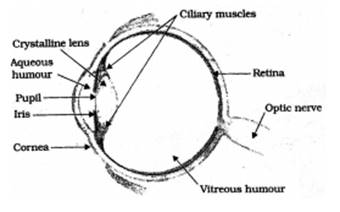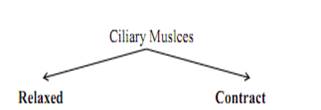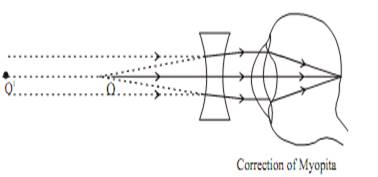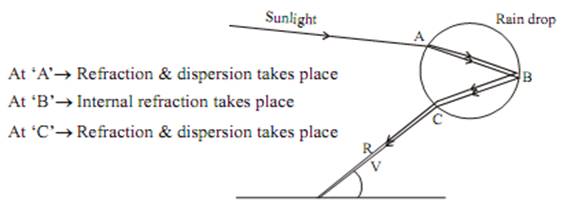
myCBSEguide App
Download the app to get CBSE Sample Papers 2023-24, NCERT Solutions (Revised), Most Important Questions, Previous Year Question Bank, Mock Tests, and Detailed Notes.
Install NowCBSE class 10 Science Chapter 11 Human Eye and Colourful World notes in PDF are available for free download in myCBSEguide mobile app. The best app for CBSE students now provides Human Eye and Colourful World class 10 Notes latest chapter wise notes for quick preparation of CBSE board exams and school based annual examinations. Class 10 Science notes on Chapter 11 Human Eye and Colourful World are also available for download in CBSE Guide website.
Human Eye and Colourful World class 10 Notes Science
Download CBSE class 10th revision notes for Chapter 11 Human Eye and Colourful World in PDF format for free. Download revision notes for Human Eye and Colourful World class 10 Notes and score high in exams. These are the Human Eye and Colourful World class 10 Notes prepared by team of expert teachers. The revision notes help you revise the whole chapter in minutes. Revising notes in exam days is on of the best tips recommended by teachers during exam days.
Revision Notes for Class 10 Science Download as PDF
CBSE Class 10 Science Revision Notes Chapter 11 Human Eye and Colourful World
- Human eye is the optical instrument used which enables us to see.
We will study various natural optical phenomenon like Rainbow formation, twinkling of star, blue and red colour of sky etc.
HUMAN EYE :
It acts like a camera, enable us to capture the colourful picture of the surroundings.
An inverted, real image on light sensitive is formed on the Retina

The Various Parts of Eye and their Functions
1. Cornea : It is a thin membrane through which light enters. It forms the transparent bulge on the front of eyeball. Most of the refraction occurs at the outer surface of the cornea.
2. Eyeball :it is a convex lens, approximately spherical in shape, with a diameter of about 2.3 cm. It can alter its curvature with help of ciliary muscles.
3. Iris :It is a dark muscular diaphragm that controls the size of pupil.It is behind the cornea.it helps in accommodation of light by changing the size of the pupil.
4. Pupil :It regulates and control the amount of light entering the eye. It is the black opening between aqueous humour& lens.BLack in colour. Light entering cannot exit.
5. Crystalline eye lens :Provides the focused real & inverted image of the object on the retina. It is composed of a fibrous, jelly like material.
This is convex lens that converges light at retina.
6. Ciliary muscles :It helps to change the curvature of eye lens and hence changes its focal length so that we can see the object clearly placed at different positions.
7. Retina : Thin membrane with large no. of light sensitive cells.
There are two types of photoreceptors in the human retina, rods and cones.
Rods are responsible for vision at low light levels . They do not mediate color vision.
Cones are active at higher light levels , are capable of color vision.
When image is formed at retina, light sensitive cells gets activated and generate electrical signal. These signals are sent to brain via optic nerve. Brain analyse these signals after which we perceive object as they are.
8. The vitreous body is the clear gel that fills the space between the lens and the retina of the eyeball of humans and other vertebrate
9. The aqueous humour is a transparent, watery fluid similar to plasma, but containing low protein concentrations.
How Pupil Works ?
Example: You would have observed that when you come out of the cinema hall after watching movie, in the bright sun light, your eyes get closed . And when you enter the hall from the bright light, you won’be able to see but after some time you would be able to see.
Here the pupil of an eye provides a variable aperture, whose size is controlled by iris
(a) When the light is bright : Iris contracts the pupil, so that less light enters the eye.
(b) When the light is dim : Iris expand the pupil, so that more light enters the eye.
Pupil opens completely, when iris is relaxed.
Persistence of Vision : It is the time for which the sensation of an object continue in the eye. It is about 1/16th of a second.
Power of Accommodation
The ability of eye lens to adjust its focal length with the help of ciliary muscles is called accommodation.

1. Eye lens becomes thin 1. Eye lens becomes thick
2. Increases the focal length 2. Decreases the focal length
3. Enable us to see distant object clearly 3.Enable us to see nearby object clearly
| Near point of the Eye It is 25cm for normal eye. The minimum distance at which object can be seen most distinctly without strain. | For point of the Eye It is infinity for normal eye. It is the farthest point upto which the eye can see objects clearly |
Defects of Vision and their Correction
1. Cataract : The image can not be seen distinctly because eye lens become milky and cloudy. This condition is known as cataract, it can cause complete or partial loss of vision.
This can be corrected by surgical removal of extra growth (cataract surgery).
2. Myopia : (Near Sightedness)
A person can see nearby object clearly, but cannot see distant object distinctly.
Image formed in front of the retina.

The Reason of defect
- Excessive curvature of eye lens means Eye lens be comes thick and its focal length decreases.
- Elongation of the eye ball.
Correction
Corrected by using a Concave Lens of appropriate power.

Hypermetropia (Far – Sightedness)
A person cannot see nearby object clearly, but can see distant object distinctly.
Image formed at a point behind the retina

The Reason of defect
1. Increase in focal length of the eye lens (Thin eye lens)
2. Eye ball has become too small.
Correction
Corrected by using a Convex Lens of appropriate power.

4. Presbyopia
As we become old, the power of accommodation of the eye usually decreases, the near point gradually recedes away. This defect is called Presbyopia, a special kind of Hypermetropia.
Person may suffer from both myopia and hypermetropia.
Reason of defect : Gradual weakening of ciliary muscles and decreasing the flexibility of the eye lens.
Correction : Using Bifocal lens with appropriate power.Bifocal lens consist of both concave and convex lens, upper position consist of concave lens and lower portion consist of convex lens action of Light through a Prism
Prism : It has two triangular bases and three rectangular lateral surfaces.
These surfaces are inclined to each other. The angle between its two lateral faces is called Angle of Prism.

Angle of Deviation (D)The angle between the incident ray and mergent ray.
Dispersion of white light by a Glass Prism

Inclined refracting surfaces of glass prism show exciting phenomenon.
Splitting of White Light into Band of Colours
The band of the coloured components of light beam is called Spectrum i.e. VIBGYOR
The splitting of light into its component colours is called Dispersion.
The different component colour of light bends at different angle with respect to incident angle, the red light bends the least while the violet bends most.
ISSAC NEWTON He was the first, who obtained spectrum of sunlight by using glass prism.
He tried to split the spectrum of white light more by using another similar prism, but he could not get any more colours.
He repeated the experiment using second prism in an inverted position with respect to the first prism.
Allowed all the colours of spectrum to pass through second prism. He found white light emerges on the other side of second prism.

He concluded that sun is made up of seven visible colour ‘VIBGYOR’
RAINBOW It is the spectrum of sunlight in nature It is formed due to the dispersion of sunlight by the tiny water droplet, present in atmosphere.
Water Droplet Act like Prism
It refracts and disperses the incident sunlight, then reflects it internally(internal reflection) and finally refracts it again, when it emerges out of the water droplet.
A rainbow is always formed in a direction opposite to that of sun.
Due to dispersion and internal reflection of light, different colours reach he observer’s eye.
Red colour appears on top & violet at the bottom of rainbow

Atmospheric Refraction
1. Apparent Star Position : It is due to atmospheric refraction of starlight.
The temperature and density of different layers of atmosphere keeps varying. Hence we have different medium.
Distant star act as point source of light. When the starlight enter the earth’s atmosphere it undergoes refraction continuously, due to changing refractive index i.e. from Rarer to denser, it bends towards the normal.
Due to this the apparent position of the star is different from actual position.
The star appears higher than its actual position.

- Twinkling of Star : It is also due to atmospheric refraction.
Distant star act like a point source of light. As the beam of starlight keeps deviating from its path, the apparent position of star keeps on changing because physical condition of earth’s atmosphere is not stationary
Hence the amount of light enters our eyes fluctuate some time bright and sometime faint.
This is the “Twinkling effect of star”.
Blue Sky
The blue color of the sky is caused by the scattering of sunlight off the molecules of the atmosphere. This scattering, called Rayleigh scattering, is more effective at short wavelengths (the blue end of the visible spectrum). Therefore the light scattered down to the earth at a large angle with respect to the direction of the sun’s light is predominantly in the blue end of the spectrum.
CBSE Class-10 Revision Notes and Key Points
Human Eye and Colourful World class 10 Notes. CBSE quick revision note for Class-10 Science, Chemistry, Maths, Biology and other subject are very helpful to revise the whole syllabus during exam days. The revision notes covers all important formulas and concepts given in the chapter. Even if you wish to have an overview of a chapter, quick revision notes are here to do if for you. These notes will certainly save your time during stressful exam days.
To download Human Eye and Colourful World class 10 Notes, sample paper for class 10 Mathematics, Social Science, Science, English Communicative; do check myCBSEguide app or website. myCBSEguide provides sample papers with solution, test papers for chapter-wise practice, NCERT solutions, NCERT Exemplar solutions, quick revision notes for ready reference, CBSE guess papers and CBSE important question papers. Sample Paper all are made available through the best app for CBSE students and myCBSEguide website.
- Chemical Reactions and Equations class 10 Notes Science
- Acids Bases and Salts class 10 Notes Science
- Metals and Non-metals class 10 Notes Science
- Carbon and its Compounds class 10 Notes Science
- Periodic Classification of Elements class 10 Notes Science
- Life Processes class 10 Notes Science
- Control and Coordination class 10 Notes Science
- How do Organisms Reproduce class 10 Notes Science
- Heredity and Evolution class 10 Notes Science
- Light Reflection and Refraction class 10 Notes Science
- Electricity class 10 Notes Science
- Magnetic Effects of Electric Current class 10 Notes Science
- Sources of Energy Current class 10 Notes Science
- Our Environment class 10 Notes Science
- Management of Natural Resources class 10 Notes Science

Test Generator
Create question paper PDF and online tests with your own name & logo in minutes.
Create Now
myCBSEguide
Question Bank, Mock Tests, Exam Papers, NCERT Solutions, Sample Papers, Notes
Install Now
Nice
nice notes but very short
Nice notes but ncert question not here write